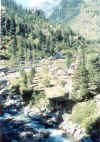|
Page 1 of 2
TAWANG MONASTERY
PRAYER FLAGS IN THE CLOUDS

Tawang Monastery
Brooding in solitary splendour, with a
grand view of the snowy Himalayas, is the Tawang Monastery in the scenic
Tawang district of Arunachal Pradesh. The hill town of Tawang is well
connected to Tibet in the north by Bum La and Tulung La passes.
 The
journey is tough, steep and peppered with hairpin bends but the scenery is
alpine and the Himalayan ranges are lush with pine, oak and rhododendron
forests. There is also an abundant growth of bamboo, which is the favourite
food of the red panda found in these parts of northeast India. Located
3400 metres [approx. 10,000 feet] above sea level, Tawang is the second
oldest monastery in Asia which explains the rush of tourists to this remote
settlement. The magnificent monastery overlooks a valley and is surrounded
by mountains that seem to be towering around it like guards. The monastery’s
enormous yellow roof and white walls stand out like a beacon. The place
seems completely isolated from the world. The
journey is tough, steep and peppered with hairpin bends but the scenery is
alpine and the Himalayan ranges are lush with pine, oak and rhododendron
forests. There is also an abundant growth of bamboo, which is the favourite
food of the red panda found in these parts of northeast India. Located
3400 metres [approx. 10,000 feet] above sea level, Tawang is the second
oldest monastery in Asia which explains the rush of tourists to this remote
settlement. The magnificent monastery overlooks a valley and is surrounded
by mountains that seem to be towering around it like guards. The monastery’s
enormous yellow roof and white walls stand out like a beacon. The place
seems completely isolated from the world.
The monastery has elaborately painted wooden windows and
other motifs. Prayer flags flutter in the breeze. The three-storeyed Dukhang [assembly hall] has
a magnificent 8-metre [26-feet] high gilded image of Buddha that attracts
scholars and pilgrims.The ancient library, leading onto the Parkhang
[main courtyard], has an excellent collection of old scriptures, images and thankas
[traditional paintings and manuscripts] depicting the Buddha and
tutelary deities in different poses. The monastery or Gompa is
over 350 years old and is an important pilgrimage for Buddhists.
flutter in the breeze. The three-storeyed Dukhang [assembly hall] has
a magnificent 8-metre [26-feet] high gilded image of Buddha that attracts
scholars and pilgrims.The ancient library, leading onto the Parkhang
[main courtyard], has an excellent collection of old scriptures, images and thankas
[traditional paintings and manuscripts] depicting the Buddha and
tutelary deities in different poses. The monastery or Gompa is
over 350 years old and is an important pilgrimage for Buddhists.
 Founded
in 1645 by Mera Lama, a contemporary of the fifth Dalai Lama, this Gelugpa
[Yellow Hat] establishment is home to a community of 500 lamas who live in
its 65 residential buildings and do their daily rituals of chanting,
praying, meditating and advancing Buddhist thought. The sixth Dalai Lama was
born here. Also known as the Galden Namgyal Lhatse the monastery is a
repository of Tibetan Buddhist culture. Founded
in 1645 by Mera Lama, a contemporary of the fifth Dalai Lama, this Gelugpa
[Yellow Hat] establishment is home to a community of 500 lamas who live in
its 65 residential buildings and do their daily rituals of chanting,
praying, meditating and advancing Buddhist thought. The sixth Dalai Lama was
born here. Also known as the Galden Namgyal Lhatse the monastery is a
repository of Tibetan Buddhist culture.
Our guide, Namgayal tells us that this divine site was
chosen by the celestial white horse. According to Buddhist legend, Mera Lama
saw the site of the Tawang monastery in a dream. He dreamt that a white
horse pawed the ground, which, upon awakening, he earmarked as the site of
the monastery. It took 40 years to complete the structure.
Tawang is located in a remote part of India amongst the
lofty Himalayan ranges. It does not have an airport or railway station of its own. It is connected by road
with other towns in Arunachal Pradesh and Assam. Getting to Tawang from
Kolkata means braving a long but rewarding journey. The drive through the
picturesque mountain country is spectacular and can leave you breathless, as
you wind around steep hill-roads and manoeuvre sharp hairpin bends. In
parts, the road can be rather treacherous and this is not a drive for the
faint-hearted!
not have an airport or railway station of its own. It is connected by road
with other towns in Arunachal Pradesh and Assam. Getting to Tawang from
Kolkata means braving a long but rewarding journey. The drive through the
picturesque mountain country is spectacular and can leave you breathless, as
you wind around steep hill-roads and manoeuvre sharp hairpin bends. In
parts, the road can be rather treacherous and this is not a drive for the
faint-hearted!
next page
Disclaimer |




